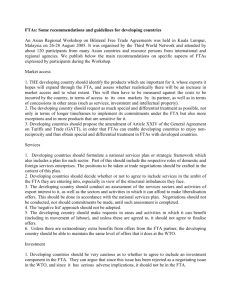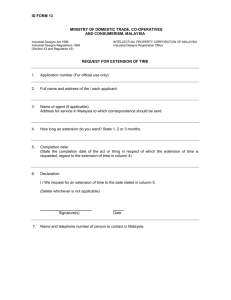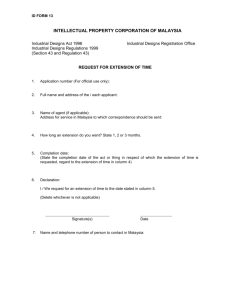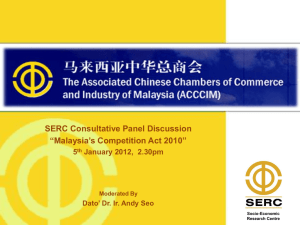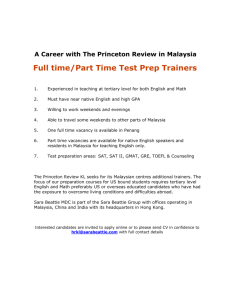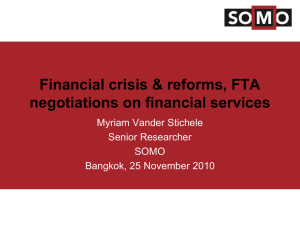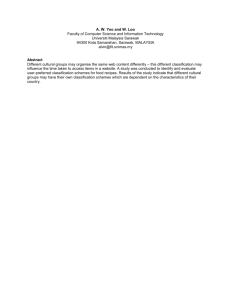CAP_memo_on_US-Malaysia_FTA
advertisement
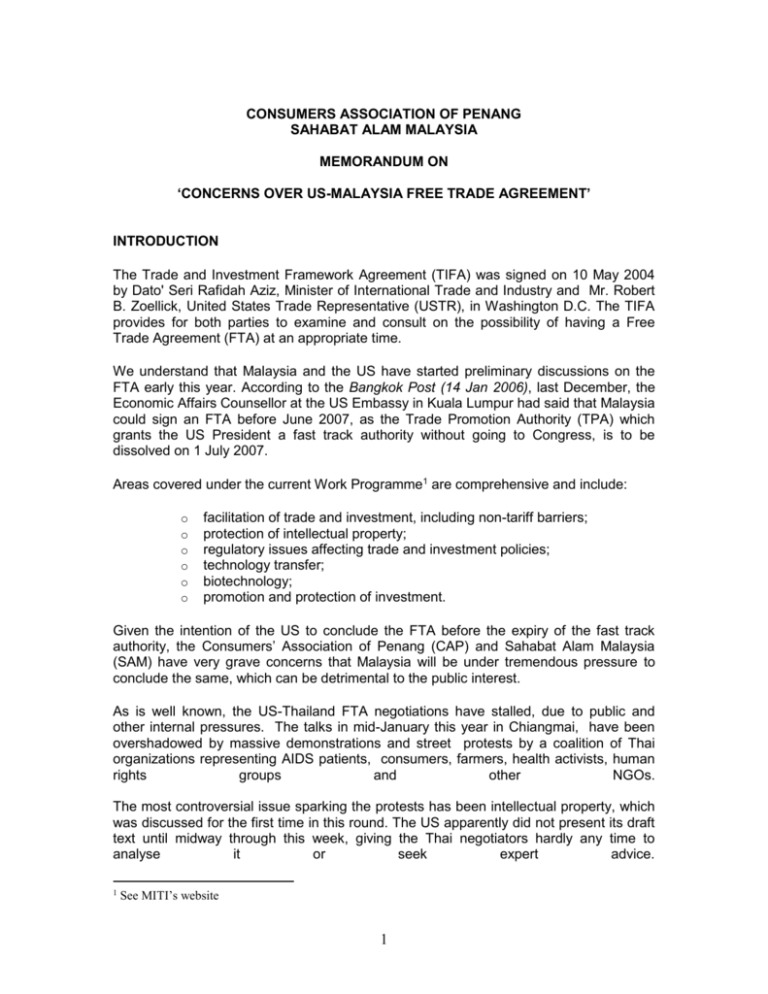
CONSUMERS ASSOCIATION OF PENANG SAHABAT ALAM MALAYSIA MEMORANDUM ON ‘CONCERNS OVER US-MALAYSIA FREE TRADE AGREEMENT’ INTRODUCTION The Trade and Investment Framework Agreement (TIFA) was signed on 10 May 2004 by Dato' Seri Rafidah Aziz, Minister of International Trade and Industry and Mr. Robert B. Zoellick, United States Trade Representative (USTR), in Washington D.C. The TIFA provides for both parties to examine and consult on the possibility of having a Free Trade Agreement (FTA) at an appropriate time. We understand that Malaysia and the US have started preliminary discussions on the FTA early this year. According to the Bangkok Post (14 Jan 2006), last December, the Economic Affairs Counsellor at the US Embassy in Kuala Lumpur had said that Malaysia could sign an FTA before June 2007, as the Trade Promotion Authority (TPA) which grants the US President a fast track authority without going to Congress, is to be dissolved on 1 July 2007. Areas covered under the current Work Programme1 are comprehensive and include: o o o o o o facilitation of trade and investment, including non-tariff barriers; protection of intellectual property; regulatory issues affecting trade and investment policies; technology transfer; biotechnology; promotion and protection of investment. Given the intention of the US to conclude the FTA before the expiry of the fast track authority, the Consumers’ Association of Penang (CAP) and Sahabat Alam Malaysia (SAM) have very grave concerns that Malaysia will be under tremendous pressure to conclude the same, which can be detrimental to the public interest. As is well known, the US-Thailand FTA negotiations have stalled, due to public and other internal pressures. The talks in mid-January this year in Chiangmai, have been overshadowed by massive demonstrations and street protests by a coalition of Thai organizations representing AIDS patients, consumers, farmers, health activists, human rights groups and other NGOs. The most controversial issue sparking the protests has been intellectual property, which was discussed for the first time in this round. The US apparently did not present its draft text until midway through this week, giving the Thai negotiators hardly any time to analyse it or seek expert advice. 1 See MITI’s website 1 Thai government negotiators have also rejected the US demands on intellectual property. According to news reports, Kanisson Navanukhro, chief of Thailand's Department of Intellectual Property Rights, said the US conditions put Thailand and Thai drug users in a disadvantaged position. He said: "We cannot accept the US demands because their conditions were created only to benefit a developed country which has an advanced pharmaceutical industry. Thailand will have nothing to gain because our capacity in producing drugs is very poor." Three of the demands by the US are said to have particularly adverse effects on access to medicines: extension of the term for drug patents; a provision for data-exclusivity for five years; and restricting the grounds for issuing a compulsory licence. Such provisions go beyond what is required under the current TRIPs agreement in the WTO and are clearly TRIPS-plus. We are therefore very concerned that similar pressures will be put on Malaysia. In the light of the above, we wish to raise the following concerns:REDUCING POLICY SPACE It is generally recognized that bilateral agreements, especially between a developing and a developed country, are not the best option and that multilateral negotiations and agreements are preferable. Among the reasons are that bilateral agreements usually lead to “trade diversion”; there is weaker bargaining power of a developing country in a negotiation with a developed country in an FTA; and bilateral FTAs are on a reciprocal basis (with little or no special and differential treatment for the developing country) with both sides aiming to eliminate tariffs on “substantially all trade” in line with World Trade Organization (WTO) rules. Another drawback is that FTAs involving a developed country usually requires the developing country to undertake WTO-plus obligations. They include rules on investment, government procurement and competition law, which have so far been rejected by developing countries as subjects for WTO negotiations or rules. Issues like labour standards and environment are also included, and have the potential to be used for protectionist purposes. Thus, new rules and obligations can enter “by the side-door” through the FTAs. Even where issues are already in the WTO (e.g. intellectual property and services), the “flexibilities” and options open to developing countries in interpreting and in implementing obligations are often removed or reduced through provisions in the FTA that are proposed by developed countries. The “policy space” for developing countries to pursue development and socio-economic goals is significantly reduced. 2 GENERAL RECOMMENDATIONS ON POLICY FRAMEWORK AND ASSESSMENT OF COSTS AND BENEFITS Negotiating an FTA is a serious exercise as the outcome can have major implications for development policy and for social, economic and development outcomes. Thus, before and while negotiating an FTA, Malaysia should ideally have the following: Need for a National Development Policy Framework Firstly, a national development policy framework comprising an overall development strategy, with sectoral national plans (for agriculture, industry and services) and issuebased plans (policies towards foreign investment, local participation in the economy, intellectual property etc). The proposals put forward by the US can then be assessed within the context of such a framework. The positions of Malaysia in the FTA can be formulated in light of the framework. Need for Framework to Assess Benefits and Costs Secondly, there should be a framework to assess the benefits and costs of the FTA, in terms of its various components and of the various proposals and provisions, and the overall balance. The benefits and costs can be assessed in terms of: (a) gains and losses in trade terms: e.g. increase in exports, imports; (b) gains and losses in terms of jobs; (c) effects on the degree of policy space and flexibilities available to the country as a result of the FTA; (d) social effects: on access to medicines, to knowledge, food security etc; (e) effects on technology transfer. The costs and benefits can be applied to the various aspects of the FTA, including market access (to the US, and the US access to Malaysia) in goods; services; intellectual property; investment, competition and government procurement; and labour and environment standards. The cross-cutting social and environmental costs can also be assessed. In general, Malaysia can expect or hope to benefit from some market access in goods from the FTA with the US, although this is likely to be constrained by onerous conditions such as rules of origin and be limited by safeguard measures. This has to be weighed against the market access to be gained by the US to Malaysia’s own home market. Malaysia can be expected to have costs arising from additional intellectual property rights (IPR) obligations beyond the TRIPS obligations. Regarding investment, government procurement and competition, there can be expected to be major costs to the Malaysia in terms of loss of policy space and the use of policy instruments. An example of a cost benefit framework is attached in the Annex 1. 3 Need For Transparency in the Process Thirdly, As part of the process, different agencies of the government should be consulted and should be part of the process of the formulation of policy and positions. It is equally important to involve stakeholders, such as local firms, trade unions, farmers, consumers, groups representing patients and those involved in health provision and environmental protection. This is especially because the US FTAs can have such wideranging effects on society. Transparency in the process with the public, and public participation in discussions on the FTA and its negotiation is thus important. What is regrettable as in the case of the Japan-Malaysia FTA, the process of negotiations was not transparent and only when the agreement was concluded, was it made available on the website of the Ministry of International Trade. There was no involvement of the stakeholders representing various sectors of society and neither was there any Parliamentary oversight as regards this. We are gravely concerned that the same non- transparent approach will be adopted as regards the US-Malaysia FTA. MARKET ACCESS A desire for expanded market access is usually the major reason why Malaysia enters an FTA. In concluded FTAs between a developed and a developing country, the developing country has obtained some extra market access. However, in many cases there have been disappointing results. There are structural, legal and political impediments that limit the offers that a developed country can make, especially on the developed country’s “sensitive products”, which are the ones that are of export interest to the developing country. US negotiators are also constrained by their Bipartisan Trade Promotion Authority Act of 2002 which prevents FTAs from reducing the rate of duty below that applicable under the Uruguay Round Agreements, on “any import sensitive agricultural product.” The Act also does not enable special and differential treatment as its negotiating objectives include ‘reciprocal market access’ and ‘to obtain reciprocal tariff and non-tariff barrier elimination agreements’. On textiles and apparel, the US typically wants the FTA partner to apply “rules of origin” that include the “yarn forward rule” where the products must be made from yarn sourced from the partner or the U.S. As developing countries usually do not have yarn industries or capability in this sector, this in effect means that US yarn has to be used, instead of cheaper yarn and fabric sourced from other, non-FTA partner, countries. There are also very cumbersome customs procedures to verify that textiles/apparel are made locally and additional safeguard measures that limit the possible market access gains. On agricultural products, the gains can be limited. For example, Australia could not get any extra sugar quota in its FTA with the US, and on beef, it only obtained an 18.5% increase in its quota, confined to manufacturing-grade beef spread over 18 years, or an extra half a cow, per farm, per year. Non-tariff barriers (e.g. sanitary and phytosanitary measures) have also limited Mexico’s expected exports of agricultural products to the USA under the North American Free Trade Agreement (NAFTA). 4 Malaysia will probably have to give reciprocal market access to the US, which is likely to be greater proportionately and greater in value, since on average its industrial tariffs are significantly higher. Eliminating its tariffs on a wide range of products can result in significant dislocation of local producers. For example, under NAFTA, Mexico agreed to eliminate tariffs on agricultural products. Imports of corn (the most widely grown crop in Mexico and the main source of income for subsistence farmers in the poor South) nearly tripled after NAFTA, and imports rose over five times for soybean, wheat, poultry and beef. This more than offset the increase in exports of fruits and vegetables (which largely accrued to multinational companies in the comparatively wealthy North – the only area which can support fruit and vegetable crops), and 1.7 million rural jobs have been lost since NAFTA. Recommendations 1. Malaysia should identify the products which are important for it, whose exports it hopes will expand through the FTA, and to assess whether realistically there will be an increase in market access and to what extent. This will then have to be measured against the costs to be incurred by the country, in terms of market access to its own markets by US, as well as in terms of concessions in other areas (such as services, investment and intellectual property). 2. Malaysia should request as much special and differential treatment as possible, not only in terms of longer implementation periods but also more exceptions and in more products that are sensitive for it. 3. Malaysia should propose the amendment of Article XXIV of the General Agreement on Tariffs and Trade (GATT), in order that FTAs can enable developing countries to enjoy non-reciprocity and thus obtain special and differential treatment in FTAs with developed countries like the US. SERVICES Services are an important sector for Malaysia. However, it is not clear if we have a national services plan which will enable us to take the appropriate positions on requests and offers in services negotiations. It is important to develop domestic services enterprises which should be given the opportunity to survive and develop, especially in socially important sectors or economically strategic sectors. While foreign services enterprises can contribute, the participation of local (public or private) enterprises is crucial, especially in these sensitive and strategic sectors. Generally, developing countries are structurally disadvantaged in attempts to get a balanced outcome in services, because they have much weaker capacity to supply services than a developed country. We should thus demand the right to offer less sectors and less commitments within each sector. A major concern is that some FTAs that include services base the concessions on a “negative list” basis, i.e. all sectors are assumed to be fully liberalized, except those listed in an annex. This will bind Malaysia to commit faster and in more sectors, as 5 compared to the “positive list” approach in the WTO (in which no sector or type of liberalization is committed unless specified in the schedule). The FTA negative list approach will also make it difficult for Malaysia to have the WTO principle followed, that it can choose the sectors to liberalise and the pace of liberalization. Such an approach reduces policy space for Malaysia. Some FTAs also oblige the partners to bind the current levels of liberalisation in the various sectors. This is different from the WTO practice, where the countries can liberalise autonomously but choose not to bind this in the WTO, or to bind at a lower level than the present practice, which allows the countries to have flexibility to change its policies if so needed, for example due to changing circumstances. It is no secret that the US is interested in the liberalization of some key strategic services sectors in Malaysia. One area which has been singled out is that of ‘financial services’. 2 Recommendations 1. Malaysia should formulate a national services plan or strategic framework, which also includes a plan for each sector. Part of this should include the respective roles of domestic and foreign enterprises. The positions taken at trade negotiations should be taken in the context of this plan. 2. Malaysia should decide whether or not to agree to include services in the FTA it is entering into, especially in view of the structural imbalances we face. 3. Malaysia should conduct an assessment of the sectors and activities of export interest to it, as well as the sectors and activities which it can afford to make offers in. This should be done in accordance with the national services plan. Negotiations should not be conducted, nor should commitments be made, until such assessment is completed. 4. The “negative list” approach should not be adopted. 5. Unless there are extraordinary extra benefits from offers from the US, Malaysia should be able to maintain the same level of offers that it does at the WTO. INVESTMENT Investment is part of the so-called “Singapore issues” in the WTO, the others being government procurement and competition. Many developing countries (led by Malaysia) were opposed the start of negotiations on an investment agreement in the WTO, as they were concerned this would prevent or reduce their policy space to determine their own investment policies, such as choice of and conditions for foreign investment, including entry requirements, equity requirements, performance requirements, regulations on funds transfer etc. The WTO in July 2004 suspended any further discussion on investment. 2 See speech of US Ambassador to Malaysia on 27 Jan 05 to American Malaysian Chamber of Commerce 6 The investment issue however is a central part of the agenda in many FTAs. The demands by US in FTAs go far beyond what was proposed in the WTO discussions on investment. For example, the US-Singapore FTA has a broad definition of investors and investments, “high” standards for the right of establishment (i.e. the provision of strong pre-establishment rights), national treatment, prohibition of performance standards, freedom for funds transfer, an expropriation clause, as well as investor-to-state dispute settlement. In FTAs involving the US, the expropriation clause typically has a broad definition of expropriation, which includes “indirect expropriation”, or losses resulting from government regulation or policy. Investors claiming to have suffered losses due to expropriation within this broad definition can take up cases against the host government for compensation. Many such investor-to-state cases have been taken up under NAFTA. Malaysia could suffer heavy penalties under the expropriation and dispute settlement provisions. The investment provisions would eliminate or drastically reduce the policy space of Malaysia. They can result in adverse effects on government’s ability to maintain or formulate social, economic and politically related policies that are required for economic development, social programmes and nation building. Recommendations 1. Malaysia should be very cautious as to whether to agree to include an investment component in the FTA. We can argue that since this issue has been rejected as a negotiating issue in the WTO, and since it has serious adverse implications, this issue should not be in the FTA. 2. If Malaysia decides to do so, it should confine the investment chapter to cooperation activities and not include binding rules on market access, investment protection and expropriation. 3. It should in particular ensure that the investment chapter does not commit it to standards and elements that may be detrimental to its investment and development policies. For example: (a) the definition of investor should not include those who “seek to invest”, as this allows for pre-establishment rights; (b) the scope of investment should only be confined to direct foreign investment, thus excluding portfolio investment, credit and intellectual property rights; (c) “indirect” expropriation should not be included; (d) there should not be an investor-to-state dispute settlement system. OTHER “SINGAPORE ISSUES”: COMPETITION, GOVERNMENT PROCUREMENT These issues, like investment, are now off the WTO negotiating agenda, at least for the duration of the Doha work programme. Many developing countries (including Malaysia) worked hard to keep them off the rubric of the multilateral trade agenda. However these topics are proposed by the US and other developed countries in bilateral FTAs. In the FTAs involving the US, the chapter on government procurement goes far beyond what was being discussed in the WTO. The WTO working group had the mandate only to discuss “transparency in government procurement”, with possible rules to be limited to 7 only the transparency aspects, and excluding market access aspects. However, the FTA chapter on government procurement covers the market access aspects, i.e. enabling foreign companies to bid on equal terms with local companies for government contracts. This would drastically limit or eliminate policy space for Malaysia to give preferential treatment to local companies and persons, and remove a crucial instrument for boosting the domestic economy. On competition policy, there was a move especially by some developed countries to introduce a competition agreement in the WTO that would enable foreign firms, goods and services to compete “equally” with local firms, through the removal of preferences and subsidization of local firms. Later, the proposal was narrowed down to initial topics such as principles of non-discrimination, transparency and procedural fairness, as well as hard core cartels and modalities for voluntary cooperation. The FTAs that involve the US typically require the developing country to establish competition legislation. Development economists have questioned whether the framework of competition policy and framework now in place in the US and other developed countries are appropriate for developing countries which are now in their developmental stage. Their concern is that this framework, which the FTA promotes, may hinder the growth of local firms and make them even less able to compete or survive against the large foreign companies especially in the face of globalization. The competition issue within trade agreements is thus extremely complex. Recommendations 1. As in the case of investment, the Malaysia can argue that these two “Singapore issues” have been suspended in the WTO as they were found inappropriate as subjects for the trade system, and that they should also not be subjects in the FTA. For example, the African Union Trade Ministers’ conference in Cairo in June 2005 declared that the Singapore issues should be kept off the agenda of their FTAs with the EU (the Economic Partnership Agreements) as it has been taken off the WTO agenda. 2. If the issues are to be included, they should be in the nature of cooperation arrangements, and not involve binding rules. 3. In particular, there should not be any market access component in the government procurement issue, should the latter be included in an FTA. INTELLECTUAL PROPERTY RIGHTS The introduction of IPRs in a trade agreement is very controversial, after the TRIPS Agreement was incorporated within the WTO. There is a growing realisation that high IPR standards, promoted by TRIPS to developing countries, are inappropriate for developing countries. Economists have estimated that the cost to developing countries of implementing TRIPS amounts to US$60 billion annually, and this more than offsets the gains they may expect to benefit from other areas, such as market access. Developing countries now seek to clarify or amend some aspects of TRIPS to reduce adverse effects. For instance the Doha Declaration on TRIPS and Public Health has clarified that developing countries can make use of “flexibilities” such as compulsory licenses. 8 Developing countries are requesting that TRIPS be amended to counter “biopiracy”, by requiring that patent applications involving biological resources be accompanied by disclosure of the countries of origin, prior informed consent and evidence of benefitsharing arrangements with the countries of origin. Also, TRIPS requires some life forms to be patented (microorganisms and micro-biological processes) but allows the prohibition of patenting of other life forms (plants and animals), and gives countries the leeway to define what is an invention and thus what is patentable. TRIPS requires that IP protection be granted to plant breeders for plant varieties; however, it allows countries flexibility to define their own “sui generis” system of protection for plant varieties. Countries can provide for farmers’ rights to save and use seeds. The FTAs with developed countries such as the US typically include extensive provisions on IPRs. The developed countries attempt to establish TRIPS-plus measures, to remove or reduce the flexibilities provided for in the TRIPS Agreement, and establish even higher standards of IPRs in developing countries. The FTAs threaten the use of TRIPS flexibilities, particularly in relation to (a) patents and access to medicines; (b) IP protection of plant varieties with respect to the sui generis system, and the rights of farmers; (c) the ability to ban patenting of some life forms; (d) copyright. [Note: Trademark and geographical indication provisions are also included in many FTAs ]. For example the WTO TRIPS Agreement does not require “data exclusivity”, i.e. that data submitted by a patent holder to drug regulatory authorities (to obtain marketing approval for safety) cannot be made use of in the approval of other applicants such as generic producers. Through bilateral FTAs, the US and EU seek “exclusive rights” over test data provided by the originator companies, which would prevent the registration and sale of generic medicines. These FTAs also modify the role of the Drug Regulatory Authority (DRA) of a country. Traditionally the DRA’s role was to assess the quality, safety and efficacy of a product, before the product is launched into the market. However the FTA provisions now require the DRA to take on the role of “patent police” by ensuring that no marketing approval is granted to generic products (while the patent on the originator product continues). Through the FTAs, the US also seeks to extend the patent life span, to allow “evergreening” practices by originator pharmaceutical companies (by renewing the expiring patents through registering “new uses” of the same product) and limiting the grounds for which compulsory licences can be issued. Some FTAs also eliminate or reduce TRIPS flexibilities in the area of intellectual property over plant varieties and other life forms. In some FTAs, the country has to allow patenting of plants and animals, and must become a Party to the 1991 Act of the International Convention for the Protection of New Varieties of Plants or UPOV 1991. The rights under UPOV 1991 are patent-like in nature with serious erosion of farmers’ rights. Obliging a country to be Party to UPOV 1991 thus removes the flexibility of choosing a sui generis system of plant variety protection that can protect farmers’ rights. 9 With regard to patents on life forms, the TRIPS Agreement allows countries to exclude plants and animals. The obligation to provide for patents on microorganisms (an area of vast commercial value) has also been interpreted by some developing countries to exclude naturally-occurring microorganisms. Some FTAs remove these flexibilities and obliges a partner country to change their national law to allow for patents over these life forms. A rising concern is the granting of “broad” patents or patents that do not meet with the criterion of “new or novel”. This has adverse implications for research and development in developing countries, as well as facilitates “biopiracy” of biological resources and associated traditional knowledge. In copyright, FTAs involving the US contain TRIPS-plus obligations, including extending the copyright period from 50 years after the death of the author to 70 years after, and providing legal protection against circumvention of technological protection measures added to copyrighted works and expansion of enforcement measures and obligations for infringement of IP (including the criminalization of counterfeiting and non-commercial copyright infringements). Some FTAs also require the developing country to become members of many IP agreements in WIPO, some of which contain TRIPs-plus provisions and standards. These FTAs also contain detailed provisions on enforcement of IPRs, thus raising the level of obligation and resource requirements demanded of national governments. Besides the above, there are many more aspects in the IP Chapter in FTAs that go beyond the TRIPS Agreement, of which Malaysia should be cautious. Recommendations 1. Malaysia should carefully consider whether to include IPRs as an item in FTAs, since there are already strict IP rules in the WTO as well as WIPO. 2. If it is agreed that an IP chapter is included, the country should try to ensure that it not include TRIPS-plus provisions. For example, there should not be restrictions on the grounds for compulsory licences, or extended protection periods for patents and copyright, or expansion of patents on life forms. An example that could be followed is that of the Australia-Thailand Free Trade Agreement which only requires the parties to respect the provisions of the TRIPS Agreement and any other multilateral agreement relating to IP to which both are parties. It also provides for cooperation clauses. 3. Malaysia should only consider acceding to or ratifying international IP agreements particularly those administered by WIPO after undertaking in-depth cost benefit analysis and understanding the implications on development and society, of each of the agreements. 10 CONCLUSION Given the dangers and risks involved in entering into the US FTA, we urge the government not to embark on such FTAs which will be imbalanced and detrimental to the interest of Malaysia and the general public. As public interest groups, we are concerned that the ongoing negotiations are not transparent and are not even brought to the attention of Parliamentarians, even though they involve critical policy issues (in areas such as agriculture, industry, services, investment, intellectual property etc) and existing legislation that affect the lives of the general public. Further, as has been the experience in many countries who have concluded such FTAs the implications for ordinary people and sustainable development are very far-reaching. We are of the view that such matters of negotiations both at the multilateral level (as in the WTO) and at the bilateral level should be open and transparent, subject to the scrutiny of the Malaysian Parliament and public debate. Critical decisions affecting national policies and sustainable development are currently being made without any public debate. This is indeed most disconcerting and we urge the Government especially MITI to make this process open and transparent, as it concerns the future of every citizen. We therefore hope that you will give this memorandum urgent attention and address our serious concerns. S.M. Mohamed Idris President Consumers Association of Penang Sahabat Alam Malaysia 11 Annex Example of FTA Cost-benefit Framework Possible benefits 1. Market access in goods: a. Agriculture b. Industrial 2. Market access in services: a. commercial services b. labour 3. Possible concessions on SPS and TBT? Possible costs 1. Market access into country: a. industrial goods b. agriculture 2. Market access into country Services 3. Intellectual property (a)Access to medicines (b) Lifeforms (c) Plant varieties (d) Biodiversity and disclosure requirements (e) Copyright and access to information (f) Broadcasting 4. Singapore Issues (a) Investment (b) Government procurement (c) Competition policy 5. Labour, environment standards 6. Environmental costs 4. Possible aid mechanisms? 5. Possible investment and technology flows 12
